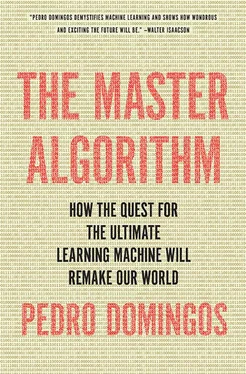My first direct experience of rule learning in action was when, having just moved to the United States to start graduate school, I applied for a credit card. The bank sent me a letter saying “We regret that your application has been rejected due to INSUFFICIENT-TIME-AT-CURRENT-ADDRESS and NO-PREVIOUS-CREDIT-HISTORY” (or some other all-cap words to that effect). I knew right then that there was much research left to do in machine learning.
Between blindness and hallucination
Sets of rules are vastly more powerful than conjunctive concepts. They’re so powerful, in fact, that you can represent any concept using them. It’s not hard to see why. If you give me a complete list of all the instances of a concept, I can just turn each instance into a rule that specifies all attributes of that instance, and the set of all those rules is the definition of the concept. Going back to the dating example, one rule would be: If it’s a warm weekend night, there’s nothing good on TV, and you propose going to a club, she’ll say yes . The table only contains a few examples, but if it contained all 2 × 2 × 2 × 2 = 16 possible ones, with each labeled “Date” or “No date,” turning each positive example into a rule in this way would do the trick.
The power of rule sets is a double-edged sword. On the upside, you know you can always find a rule set that perfectly matches the data. But before you start feeling lucky, realize that you’re at severe risk of finding a completely meaningless one. Remember the “no free lunch” theorem: you can’t learn without knowledge. And assuming that the concept can be defined by a set of rules is tantamount to assuming nothing.
An example of a useless rule set is one that just covers the exact positive examples you’ve seen and nothing else. This rule set looks like it’s 100 percent accurate, but that’s an illusion: it will predict that every new example is negative, and therefore get every positive one wrong. If there are more positive than negative examples overall, this will be even worse than flipping coins. Imagine a spam filter that decides an e-mail is spam only if it’s an exact copy of a previously labeled spam message. It’s easy to learn and looks great on the labeled data, but you might as well have no spam filter at all. Unfortunately, our “divide and conquer” algorithm could easily learn a rule set like that.
In his story “Funes the Memorious,” Jorge Luis Borges tells of meeting a youth with perfect memory. This might at first seem like a great fortune, but it is in fact an awful curse. Funes can remember the exact shape of the clouds in the sky at an arbitrary time in the past, but he has trouble understanding that a dog seen from the side at 3:14 p.m. is the same dog seen from the front at 3:15 p.m. His own face in the mirror surprises him every time he sees it. Funes can’t generalize; to him, two things are the same only if they look the same down to every last detail. An unrestricted rule learner is like Funes and is equally unable to function. Learning is forgetting the details as much as it is remembering the important parts. Computers are the ultimate idiot savants: they can remember everything with no trouble at all, but that’s not what we want them to do.
The problem is not limited to memorizing instances wholesale. Whenever a learner finds a pattern in the data that is not actually true in the real world, we say that it has overfit the data. Overfitting is the central problem in machine learning. More papers have been written about it than about any other topic. Every powerful learner, whether symbolist, connectionist, or any other, has to worry about hallucinating patterns. The only safe way to avoid it is to severely restrict what the learner can learn, for example by requiring that it be a short conjunctive concept. Unfortunately, that throws out the baby with the bathwater, leaving the learner unable to see most of the true patterns that are visible in the data. Thus a good learner is forever walking the narrow path between blindness and hallucination.
Humans are not immune to overfitting, either. You could even say that it’s the root cause of a lot of our evils. Consider the little white girl who, upon seeing a Latina baby at the mall, blurted out “Look, Mom, a baby maid!” (True event.) It’s not that she’s a natural-born bigot. Rather, she overgeneralized from the few Latina maids she has seen in her short life. The world is full of Latinas with other occupations, but she hasn’t met them yet. Our beliefs are based on our experience, which gives us a very incomplete picture of the world, and it’s easy to jump to false conclusions. Being smart and knowledgeable doesn’t immunize you against overfitting, either. Aristotle overfit when he said that it takes a force to keep an object moving. Galileo’s genius was to intuit that undisturbed objects keep moving without having visited outer space to witness it firsthand.
Learning algorithms are particularly prone to overfitting, though, because they have an almost unlimited capacity to find patterns in data. In the time it takes a human to find one pattern, a computer can find millions. In machine learning, the computer’s greatest strength-its ability to process vast amounts of data and endlessly repeat the same steps without tiring-is also its Achilles’ heel. And it’s amazing what you can find if you search enough. The Bible Code , a 1998 bestseller, claimed that the Bible contains predictions of future events that you can find by skipping letters at regular intervals and assembling words from the letters you land on. Unfortunately, there are so many ways to do this that you’re guaranteed to find “predictions” in any sufficiently long text. Skeptics replied by finding them in Moby Dick and Supreme Court rulings, along with mentions of Roswell and UFOs in Genesis. John von Neumann, one of the founding fathers of computer science, famously said that “with four parameters I can fit an elephant, and with five I can make him wiggle his trunk.” Today we routinely learn models with millions of parameters, enough to give each elephant in the world his own distinctive wiggle. It’s even been said that data mining means “torturing the data until it confesses.”
Overfitting is seriously exacerbated by noise. Noise in machine learning just means errors in the data, or random events that you can’t predict. Suppose that your friend really does like to go clubbing when there’s nothing interesting on TV, but you misremembered occasion number 3 and wrote down that there was something good on TV that night. If you now try to come up with a set of rules that makes an exception for that night, you’ll probably wind up with a worse answer than if you’d just ignored it. Or suppose that your friend had a hangover from going out the previous night and said no when ordinarily she would have said yes. Unless you know about the hangover, learning a set of rules that gets this example right is actually counterproductive: you’re better off “misclassifying” it as a no. It gets worse: noise can make it impossible to come up with any consistent set of rules. Notice that occasions 2 and 3 are in fact indistinguishable: they have exactly the same attributes. If your friend said yes on occasion 2 and no on occasion 3, there’s no rule that will get them both right.
Overfitting happens when you have too many hypotheses and not enough data to tell them apart. The bad news is that even for the simple conjunctive learner, the number of hypotheses grows exponentially with the number of attributes. Exponential growth is a scary thing. An E. coli bacterium can divide into two roughly every fifteen minutes; given enough nutrients it can grow into a mass of bacteria the size of Earth in about a day. When the number of things an algorithm needs to do grows exponentially with the size of its input, computer scientists call it a combinatorial explosion and run for cover. In machine learning, the number of possible instances of a concept is an exponential function of the number of attributes: if the attributes are Boolean, each new attribute doubles the number of possible instances by taking each previous instance and extending it with a yes or no for that attribute. In turn, the number of possible concepts is an exponential function of the number of possible instances: since a concept labels each instance as positive or negative, adding an instance doubles the number of possible concepts. As a result, the number of concepts is an exponential function of an exponential function of the number of attributes! In other words, machine learning is a combinatorial explosion of combinatorial explosions. Perhaps we should just give up and not waste our time on such a hopeless problem?
Читать дальше












